THE GROWTH OF THE STEAM-ENGINE.
CHAPTER I.
THE
STEAM-ENGINE AS A SIMPLE MACHINE.
SECTION
I.THE PERIOD OF SPECULATIONFROM HERO TO WORCESTER,
B.
C. 200 TO A. D. 1650.
ONE
of the greatest of modern philosophers the founder of that system of
scientific philosophy which traces the processes of evolution in every
department, whether physical or intellectualhas devoted a chapter of his
" First Principles " of the new system to the consideration of the
multiplication of the effects of the various forces, social and other, which
are continually modifying this wonderful and mysterious universe of which we
form a part. Herbert Spencer, himself an engineer, there traces the
wide-spreading, never-ceasing influences of new inventions, of the introduction
of new forms of mechanism, and of the growth of industrial organization, with a
clearness and a conciseness which are so eminently characteristic of his style.
His illustration of this idea by reference to the manifold effects of the
introduction of steam-power and its latest embodiment, the locomotive-engine,
is one of the strongest passages in his work. The power of the steam-engine,
and its inconceivable importance as an agent of civilization, has always been a
favorite theme With philosophers and historians as well as poets. As Religion
has always been, and still is, the great agent in civilizing the world, and as
Science is the great intellectual promoter of civilization, so the Steam-Engine
is, in modern times, the most important physical agent in that great work.
It would be superfluous to attempt to enumerate the benefits which it has
conferred upon the human race, for such an enumeration would include an
addition to every comfort and the creation of almost every luxury that we now
enjoy. The wonderful progress of the present century is, in a very great
degree, due to the invention and improvement of the steam-engine, and to the
ingenious application of its power to kinds of work that formerly taxed the physical
energies of the human race. We cannot examine the methods and processes of any
branch of industry without discovering, somewhere, the assistance and support
of this wonderful machine. Relieving mankind from man- usual toil, it has left
to the intellect the privilege of directing the power, formerly absorbed in
physical labor, into other and more profitable channels. The intelligence which
has thus conquered the powers of Nature, now finds itself free to do head-work;
the force formerly utilized in the carrying of water and the hewing of wood, is
now expended in the God-like work of Thought. What, then, can be more
interesting than to trace the history of the growth of this wonderful machine?
the greatest among the many great creations of one of God's most beneficent
gifts to man the power of invention. While following the records and
traditions which relate to the steam-engine, I propose to call attention to the
fact that its history illustrates the very important truth: inventions are
never, as great discoveries are seldom, the work of any one mind. Every great
invention is really either an aggregation of minor inventions, or the final
step of a progression. It is not a creation, but a growth as truly so as is
that of the trees in the forest., the same invention is frequently brought out
in several countries, and by several individuals, simultaneously. Frequently an
important invention is made before the world is ready to receive it, and the
unhappy inventor is taught, by his failure, that it is as unfortunate to be in
advance of his age as to be behind it. Inventions only become successful when
they are not only needed, but when mankind is so far advanced in intelligence
as to appreciate and to express the necessity for them, and to at once make use
of them.
More than half a century ago, an able New England writer, in a communication to
an English engineering periodical, described the new machinery which was built
at Newport, R. I., by John Babcock and Robert L. Thurston, for one of the first
steamboats that ever ran between that city and New York. He prefaced his
description with a frequently-quoted remark to the effect that, as Minerva
sprang, mature in mind, in full stature of body, and completely armed, from the
head of Jupiter, so the steam-engine came forth, perfect at its birth, from the
brain of James Watt. But we shall see, as we examine the records of its history
that, although James Watt was an inventor, and probably the greatest of the
inventors of the steam-engine, he was still but one of the many men who have
aided in perfecting it, and -who have now made us so familiar with it, and its
tremendous power and its facile adaptations, that we have almost ceased to
admire it, or to wonder at the workings of the still more admirable intelligence
that has so far perfected it.
Twenty-one centuries ago, the political power of Greece was broken, although
Grecian civilization had risen to its zenith. Rome, ruder than the polished
neighbor, was growing continually stronger, and -was rapidly gaining territory
by absorbing weaker states. Egypt, older in civilization than either Greece or
Rome, fell but two centuries later before the assault of the younger states,
and became a Roman province. Her principal city was at this time Alexandria,
founded by the great soldier whose name it bears, when in the full tide of his
prosperity. It had now become a great and prosperous city, the center of the
commerce of the would, the home of students and of learned men, and its
population was the wealthiest and most civilized of the then known world.
It is among the relics of that ancient Egyptian civilization that we find the
first records in the early history of the steam-engine. In Alexandria, the home
of Euclid, the great geometrical, and possibly contemporary with that talented
engineer and mathematician, Archimedes, a learned writer called Hero, produced
a manuscript which he entitled "Spiritalia seu Pneumatica."
It is quite uncertain whether Hero was the inventor of any number of the
contrivances described in his work. It is most probable that the apparatus
described are principally devices which had either been long known, or which
were invented by Cestesibus, an inventor who was famous for the number and
ingenuity of the hydraulic and pneumatic machines that he devised. Hero states,
in his Introduction, his intention to describe existing machines and earlier
inventions, and to add his own. Nothing in the text, however, indicates to whom
the several machines are to be ascribed. (1)
The
first part of Hero's work is devoted to applications of the siphon. The 11th
proposition is the first application of heat to produce motion of fluids. An
altar and its pedestal are hollow and air-tight. A liquid is poured into the
pedestal, and a pipe inserted, of which the lower end passes beneath the
surface of the liquid, and the upper extremity leads through a figure standing
at the altar, and terminates in a vessel inverted above this altar. When a fire
is made on the altar, the heat produced expands the confined air, and the
liquid is driven up the tube, issuing from the vessel in the hand of the figure
standing by the altar, which thus seems to be offering a libation. This toy
embodies the essential principle of all modern heat-enginesthe change of
energy from the form known as heat-energy into mechanical energy, or work. It
is not at all improbable that this prototype of the modern wonder-working
machine may have been known centuries before the time of Hero. Many forms of
hydraulic apparatus, including the hand fire-engine, which is familiar to us,
and is still used in many of our smaller cities, are described, the greater
number of which are probably attributable to Cestibus. They demand no
description here. A hot-air engine, however, which is the subject of his 35th
proposition, is of real interest.
1
The British Museum contains four manuscript topics of Micro's "
Pneu-matics," which was written in the fifteenth and sixteenth centuries.
Those manuscripts have been examined with great care, and a translation from
them prepared by Prof. J. G. Greenwood, and published at the desire of Mr.
Bennett Wooderoft, the author of a valuable little treatise on "Steam
Navigation." This is, so far as the author is aware, the only existing
English translation of any portion of Hero's works.
Hero
sketches and describes a method of opening temple-doors by the action of fire
on an altar, which is an ingenious device, and contains all the elements of the
machine of the Marquis of Worcester, which is generally considered the first
real steam-engine, with the single and vital defect that the expanding fluid is
air instead of steam. The sketch, from Greenwood's translation, exhibits the
device very plainly. Beneath the temple-doors, in the space , is placed a
spherical vessel, B, containing water. A pipe, FG, connects the upper part of
this sphere with the hollow and air-tight shell of the altar above, B E.
Another pipe, leads from the bottom of the vessel
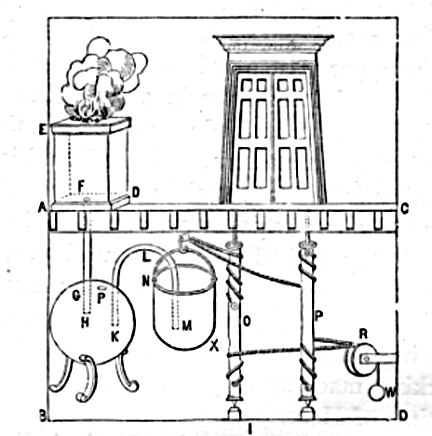
Fig.
1.-Opening Temple-Doors by Steam, B.C. 200.
at
their feet, and carrying the doors above. Ropes led over a pulley, R, sustain a
counterbalance, lF: On building a fire on the altar, the heated air within
expands, passes through the pipe, and drives the water contained in the vessel,
Et through the siphon, into the bucket. The weight of the bucket, which then
descends, turns the barrels, OP, raises the counterbalance, and opens the doors
of the temple. On extinguishing the fire, the air is condensed, the water
returns through the siphon from the bucket to the sphere, the counterbalance
falls, and the doors are closed.
Another
contrivance is next described, in which the bucket is replaced by an air-tight
bag, which, expanding as the heated air enters it, contracts vertically and
accentuates the mechanism, which in other respects is similar to that just
described.
In
these devices the spherical vessel is a perfect anticycle, S; over, in
siphon-shape, to the bottom of a suspended bucket. The suspending cord is
carried over a pulley and led around two vertical barrels, O P, turning on
pivots portion of the vessels used many centuries later by several so-called
inventors of the steam-engine Proposition 45 describes the familiar experiment
of a ball supported aloft by a jet of fluid. In this example steam is generated
in a close cauldron, and issues from a pipe inserted in the top, the ball
dancing on the issuing jet.
No. 47 is a device subsequently reproducedperhaps reinvented by the second
Marquis of Worcester.

Fig. 2.-Steam Fountain, B.C. 200.
A
strong, close vessel, forms a pedestal, on which are mounted a spherical
vessel, E1 and a basin. A pipe, is led from the bottom of the larger vessel into
the upper part of the sphere, and another pipe from the lower part of the
latter, in the form of a siphon, over to the basin, J I A drain-pipe, 1V O,
leads from the basin to the reservoir, A D. The whole contrivance is called
"A fountain which is made to blow by the action of the sun's rays."
It is operated thus: The vessel, E.g. being filled nearly to the top with
water, or other liquid, and exposed to the action of the sun's rays, the air
above the water expands, and drives the liquid over, through the siphon, G,
into the basin, M, and it will fall into the pedestal, A,B,C, and D.
Hero goes on to state that, on the removal of the sun's rays, the air in the
sphere will contract, and that the water will be returned to the sphere from
the pedestal. This can, evidently, only occur when the pipe G is closed
previous to the commencement of this cooling. No such cork is mentioned, and it
is not unlikely that the device only existed on paper.
Several steam-boilers are described, usually simple pipes or cylindrical
vessels, and the steam generated in them by the heat of the fire on the altar
forms a steam-blast. This blast is either directed into the fire, or it "
makes a blackbird sing," blows a horn for a triton, or does other equally
useless work. In one device, No. 70, the steam issues from a reaction-wheel
revolving in the horizontal plane, and causes dancing images to circle about
the altar. A more mechanical and more generally-known form of this device is
that which is frequently described as the " First Steam Engine." The
sketch from Start is similar in general form, but more elaborate in detail,
than that copied by Greenwood, which is here also reproduced, as representing
more accurately the simple form which the mechanism on pivot, L, and the other,
H opening directly into the sphere at G.
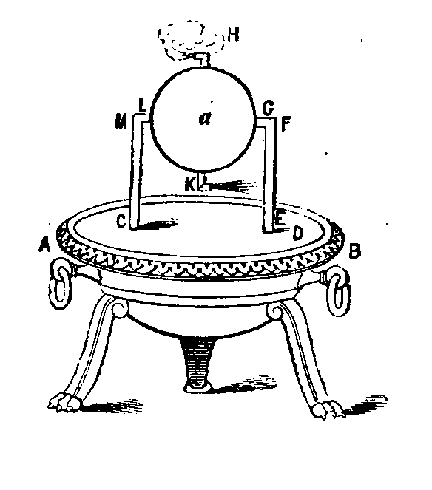
Fig. 3.- Hero's Engine, B.C. 200.
Short,
bent pipes, and issue from points diametrically opposite each other, and are
open at their extremities.A fire being made beneath the cauldron, steam is
formed and finds exit through the pipe, EF G, into the globe, and thence rushes
out of the pipes, turning the globe on its axis, G b, by the unbalanced
pressure this produced. The more elaborate sketch which forms the frontis-piece
represents a machine of similar character. Its design and ornamentation
illustrate well the characteristics consisted of a globe, X suspended between
edges, G O, through one of which steam enters from the boiler, P, below. The
hollow, bent arms, XV and Z, cause the vapor to issue in such directions that
the reaction produces a rotary movement of the globe, just as the rotation of
reaction water-wheels is produced by the out- flowing water.
It is
quite uncertain whether this machine was evermore than a toy, although it has
been supposed by state authorities that it was actually used by the Greek priests
for the purpose of producing motion of apparatus in their temples. It seems
sufficiently remarkable that, while the power of steam had been, during all the
many centuries that man has existed upon the globe, so impossibly displayed in
so many of the phenomena of natural change, that mankind lived almost up to the
Christian era without making it useful in giving motion even to a toy; but it
excites still greater surprise that, from the time of Hero, we meet with no
good evidence of its application to practical purposes for many hundreds of
years.
Here
and there in the pages of history, and in special treatises, we find a hint
that the knowledge of the force of steam was not lost; but it is not at all to
the credit of -biographers and of historians, that they have devoted 60 little
time to the task of seeking and recording information relating to the progress
of this and other important inventions and improvements in the mechanic arts.
Malmesbury
states that, in the year A. D. 1120, there existed at Rheims, in the church of
that town, a clock designed or constructed by Gerbert, a professor in the
schools there, and an organ blown by air escaping from a vessel in which it was
compressed " by heated water."
Hieronymus
Cardan, a wonderful mathematical genius, a most eccentric philosopher, and a
distinguished physician, about the middle of the sixteenth century called
attention, in his writings, to the power of steam, and to the facility with
which a vacuum can be obtained by its condensation. This Cardan was the author
of " Cardan's Formula," or rule for the solution of cubic equations,
and was the inventor of the "smoke-jack." He has been called a
"philosopher, juggler, and madman." He was certainly a learned
mathematician, a skillful physician, and a good mechanic.
Many traces are found, in the history of the sixteenth century, of the
existence of some knowledge of the properties of steam, and some anticipation
of the advantages to follow its application. Matthesius, A. D. 1571, in one of
his sermons describes a contrivance which may be termed a steam-engine, and
enlarges on the " tremendous results which may follow the volcanic action
of a small quantity of confined vapor; " 2 and another writer applied the
steam according to Hero to turn the spit, and thus rivaled and excelled Cardan,
who was introducing his " smoke-jerk."
xAs
Start says, the inventor enumerated its excellent qualities with great
minuteness. He claimed that it would " eat nothing, and giving, withal, an
assurance to those partaking of the feast, whose suspicious natures nurse
queasy appetites, that the haunch has not been pawed by the turn- spit in the
absence of the housewife's eye, for the pleasure of licking his unclean
fingers." Jacob Benson, a Professor of Mathematics and Natural Philosophy
at Orleans, and who was in his time distinguished as a mechanic, and for his
ingenuity in contriving illustrative models for use in his lecture-room, left
evi-dence, which Beroaldus collected and published in 1578, that he had found
the spirit of his time sufficiently enlightened to encourage him to pay great
attention to applied mechanics and to mechanism. There is at this time marked
awakening of the more intelligent men of the age to the value of practical
mechanics. A scientific tract, published at Orleans in 151;9, and probably
written by Besson, describes very intelligently the generation of steam by the
communication of heat to water, and its peculiar properties.
The
French were now becoming more interested in mechanics and the allied sciences,
and philosophers and literati, of native birth and imported by the court from
other countries, were learning more of the nature and importance of such
studies as have a bearing upon the work of the engineer and of the mechanic.
Agostino
Ramelli, an Italian of good family, a student and an artist when at leisure, a
soldier and an engineer in busier times, was born and educated at Rome, but
subsequently was induced to make his home in Paris. He published a book in
1588,3 in which he described many machines, adapted to various purposes, with a
skill that was only equaled by the accuracy and general excellence of his
delineations. This work was produced while its author was' History of the
Steam- Engine," 1825. " Theatrum Instrumcntorum et Machinarum, Facobi
Bessoni, cumFranc Beroaldus, figuarum declaratione demonstrative."
Lugduni, residing at the French capital, supported by a pension which had been
awarded him by Henry III. as a reward for long and faithful services. The books
of Besson and of Ramelli are the first treatises of importance on general
machinery, all were, for many years, at once the sources from which later
writers drew the principal portion of their information in relation to
machinery, and wholesome stimulants to the study of mechanism. These works
contain descriptions of many machines subsequently reinvented and claimed as
new by other mechanics.
Leonardo da Vinci, well known as a mathematician, engineer, poet, and painter,
of the sixteenth century, describes, it is said, a steam-gun, which he calls
the " Architonnerre, and ascribes to Archimedes. It was a machine composed
of copper, and seems to have had considerable power. It threw a ball weighing a
talent. The steam was generated by permitting water in a closed vessel to fall
on surfaces heated l 8, by a charcoal fire, and by its sudden expansion to
eject the ball.
In
the year 1825, the superintendent of the royal Spanish archives at Simancas
furnished an account which, it was said, had been there discovered of an
attempt, made in 1543 by Blasco de Garay, a Spanish navy-officer under Charles
V., to move a ship by paddle-wheels, driven, as was inferred from the account,
by a steam-engine. It is impossible to say to how much credit the story is
entitled, but, if true, it was the first attempt so far as is now known, to
make steam useful in developing power for practical purposes. Nothing is known
of the form of the engine employed, it only having been stated: " vessel
of boiling water formed a part of the apparatus.
The
account is, however, in other respects so circumstantial, that it has been
credit by many; but it is regarded as apocryphal by the majority of writers
upon the subject. It was published in 1695.
Zach's
"Astronomical Correspondence," in the form of a letter from Thomas
Gonzales, Director of the Royal Archives at Simancas, Spain. In l7Ol, Giovanni
Battista della Porta, in a work called "Spiritali," described an
apparatus by which the pressure of steam might be made to raise a column of
water. It included the application of the condensation of steam to the
production of a vacuum into which the water would flow.
Porta
is described as a mathematician, chemist, and physicist, a gentleman of
fortune, and an enthusiastic student of science. His home in Naples was a
rendezvous for students, artists, and men of science distinguished in every
branch. He invented the magic lantern and the camera obscured, and described it
in his commentary on the "Pneumatica." In his work1 he described this
machine for raising water, as shown in Fig. 4, which differs from one shown by
Hero in the use of steam pressure, instead of the pressure of heated air, for
expelling the liquid.
The
retort, or boiler, is fitted to a tank from which the bent pipe leads into the
external air. A fire being kindled under the retort, the steam generated rises
to the upper part of the tank, and its pressure on the surface of the water
drives it out through the pipe, and it is then led to any desired height. This
was called by Porta an improved " Hero's Fountain," and was named his
" Steam Fountain." He described with perfect accuracy the action of
condensation in producing a vacuum, and sketched an apparatus in which the
vacuum thus secured was filled by water forced in by the pressure of the
external atmosphere. His contrivances was not apparently ever applied to any
practically useful purpose. We have not yet passed out of the age of
speculation, and are just approaching the periods of application: Porta is,
nevertheless, entitled to credit as having proposed
1"Pneumaticorum
libraries," etc., 4to. Naples, 1601. "I Pre Libri Spiritali."
Napoli, 1606.
an
essential change in this succession, which begins with Hero, and which did not
end with Watt. The use of steam in Hero's fountain was as necessary a step as,
although less striking than, any of the subsequent modifications of the
machine. In Porta's contrivance, too, we should note particularly the
separation of the boiler from the " forcing vessel "a plan often
claimed as original with later inventors, and as constituting a fair ground for
special distinction.
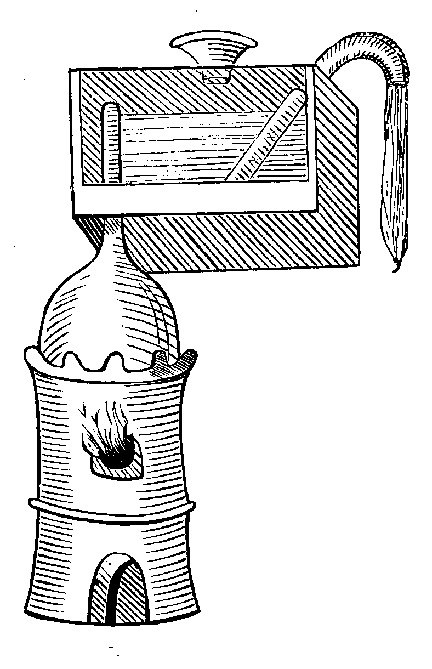
Fig. 4.Porta's
Apparatus, A. D. 1601.
The
rude engraving (Fig. 4) above is copied from the book of Porta, and shows
plainly the boiler mounted above a furnace, from the door of which the flame is
seen issuing, and above is the tank containing water. The opening in the top is
closed by the plug, as shown, and the steam issuing from the boiler into the
tank near the top, the water is driven out through the pipe at the left,
leading up from the bottom of the tank. Florence Rivault, a Gentleman of the
Bedchamber to
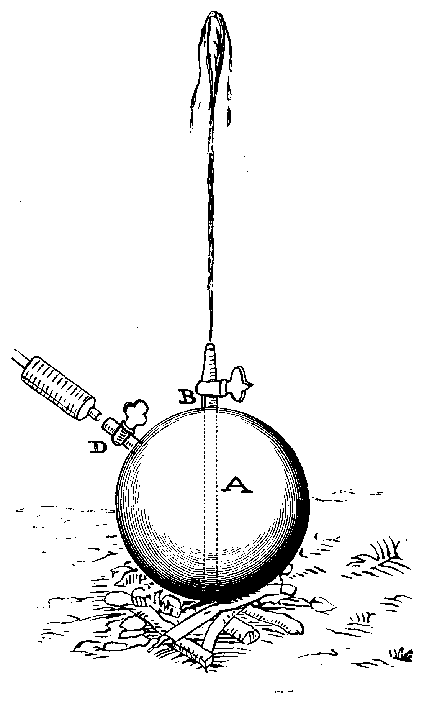
Fig. 5.De
Caus's Apparatus, A. D. 1605.
Henry
IV., and a teacher of Louis XIII., is stated by M. Arago, the French
philosopher, to have discovered, as early as 1606, that water confined in a
bombshell and there heated would explode the shell, however thick its walls
might be made. The fact is that he published in Rivault's treatise on artillery
in 1608. He said: " The water is converted into air, and its vaporization
is followed by violent explosion."
In
1615, Salomon de Caus, who had been an engineer and architect under Louis XIII.
of France, and later in the employ of the English Prince of Wales, published a
work at Frankfort, entitled " Les Raisons des Forces Mouvantes, avec
diverses machines tant utile que plaisante," in which he illustrated his
proposition, " Water will, by the aid of fire, mount higher than its
source," by describing a machine designed to raise water by the expanding
power of steam.
In
the sketch here given (Fig. 6), and which is copied from the original in "
Les Raisons des Forces Mouvantes," etc., A is the copper ball containing
water; in, the cock at the extremity of the pipe, taking water from the bottom,
C', of the vessel; 1), the cock through which the vessel is filled. The sketch
was probably made by De Caus's own hand.
The
machine of De Caus, like that of Porta, thus consisted of a metal vessel partly
filled with water, and in which a pipe was fitted, leading nearly to the
bottom, and open at the top. Fire being applied, the steam formed by its
elastic force drove the water out through the vertical pipe, raising it to a height
limited only by either the desire of the builder or the strength of the vessel.
In
1629, Giovanni Branea, of the Italian town of Loretto, described, in a work'
published at Rome, a number of ingenious mechanic contrivances, among which was
a steam-engine in which the steam, issuing from a boiler, impinged on the basis
of a horizontal well. This it was proposed to apply to many useful purposes.
At
this time experiments were in progress in England which resulted in the useful
application of steampower to raising water. A patent, dated January 21,1630,
was granted to David Ramseye l by Charles I., which covered a number of
distinct
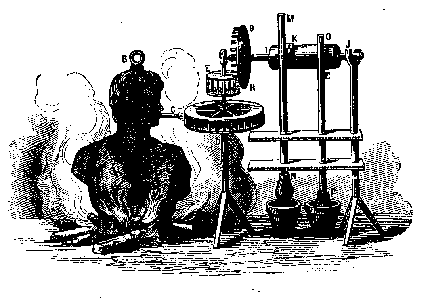
Fig. 6.Brancas
Steam-Engine, A.D. 1629.
inventions.
These were: " 1. To multiply and make saltpeter in any open field, in four
acres of ground, sufficient to serve all our dominions. 2. To raise water from
low paths by fire. 3. To make any sort of mills to grow on standing waters by
continual motion, without help of wind, water, or horse. 4. To make all sorts
of tapestries without any weaving‑loom, or whatever yet in use in this
kingdome. 5. To make boats, ships, and barges to grow against strong wind and
tide. 6. To make the earth more fertile than usual. 7. To raise water from low
places and mines, and coal paths, by 3 new water never yet inside. 8. To make
hard iron soft, and likewise copper to the tuff and soft, while it is not in
use in this kingdome 9. To make velvet white varying speed." This seems to
have been the first authentic reference to the use of steam in the arts which
has been found in English literature. The patentee helping his grant fourteen
years, on condition of paying an annual fee of £3628 to the Crown.
l
Rymer's " Federa," Sanderson. Ewbank's " Hydraulics," p.
419.
The
second claim is distinct as an application of steam, the language being that
which was then, and for a century and a half subsequently, always employed in
speaking of its use. The steam‑engine, in all its forms, was at that time known
as the " fire‑engine." It would seem not at all improbable that the
third, fifth, and seventh claims are a]so applications of steam‑power.
Thomas
Grant, in 1632, and Edward Ford, in 11)40, also patented schemes, which have
not been described in detail, for moving ships against wind and tide by some
new and great force.
Dr.
John Wilkins, Bishop of Chester, an eccentric but learned and acute scholar,
described, in 1648, Cardan's smoke‑jack, the earlier prototypes, and the power
of the confined steam, and suggested, in a humorous discourse, what he thought
to be perfectly feasiblethe construction of a flying‑machine. He says: "
Not a ' high pressure ' be applied with advantage to move wings as large as
those of the ' ruckus ' or the ' chariot ' ? The engineer might probably find a
corner that would do for a coal‑station near some of the 'castles"'
(castles in the air). The reverend wit proposed the application of the smokejack
to the chiming of bells, the feeling of yarn, and to rocking the cradle.
Bishop
Wilkins writes, in 1648 (" Mathematical Logic "), of things as
familiar and useful pieces of apparatus, and describes them as consisting
" of some such material as may endure the fire, having a small hole at
which they are filled with water, and out of wllich (when the vessels are
heated) the air doth issue forth with a strong and lasting violence."
" They are," the bishop adds, " frequently used for the exciting
and contracting of heat in the melting of glasses or metals. They may also be
contrived to be serviceable for sundry other pleasant uses, as for the moving
of sails in a chimney‑corner, the motion of which sails may be applied to the
turning of a spit, or the like."
Kircher
gives an engraving (" Mundus Subterraneus ") showing the last‑named
application; and Erekern ("Aula Subterrallea,'' 1672) gives a picture
illustrating their application to the production of a blast in smelting ores.
They seem to have been frequently used, and in all parts of Europe, during the
seventeenth century, for blowing fires in houses, as well as in the practical
work of the various trades, and for improving the draft of chimneys. The latter
application is revived very frequently by the modern inventor.
We
next meet with the first instance in which the expansive force of steam is
supposed to have actually been applied to do important and useful work.
In
1663, Edward Somerset, second Marquis of Worcester, published a curious
collection of descriptions of his inventions, couched in obscure and singular
language, and called " A Century of the Names and Scantlings of Inventions
by me already Practiced."
One
of these inventions is an apparatus for raising water by steam. The description
was not accompanied by a drawing, but the sketch here given (Fig. 7) is thought
probably to resemble one of his earlier contrivances very closely. Steam is
generated in the boiler (e, and thence is led into the vessel e, already nearly
filled with water, and fitted up like the apparatus of De Caus. It drives the
water in a jet out through the pipe. The vessel C is then shut off from the
boiler a, is again filled through the pipe h, and the operation is repeated.
Start thinks it possible that the larger may have even been in the engine with
a piston. The instruments of Porta were "steam fountains," and were
probably applied, if use(l at all, merely to ornamental purposes. That of the
Worcester was actually used for the purpose of elevating, water for practical
purposes at Vauxhall, near London.
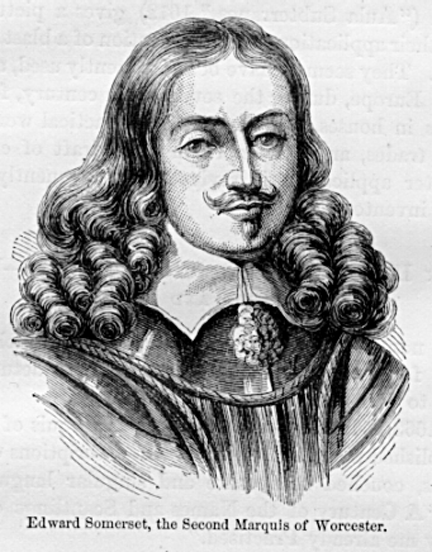
Edward
Somerset, the Second Marquis of Worcester.
Worcester
was actually used for the purpose of elevating, water for practical purposes at
Vauxhall, near London.
This
Invention was introduced at Rawlan Castle by Worcester is not known but it was
probably not much later than 1665. In 1667 Direks shows the marquis probably to
have been engaged in getting out parts of the later engine which was erected at
Vauxhall, obtaining his materials Tom Macilliam Lambert, a brass‑founder. His
patent was issued in June, 1662. He could nowhere find an illustrated
description of the machine, or such an account as would enable a mechanic to
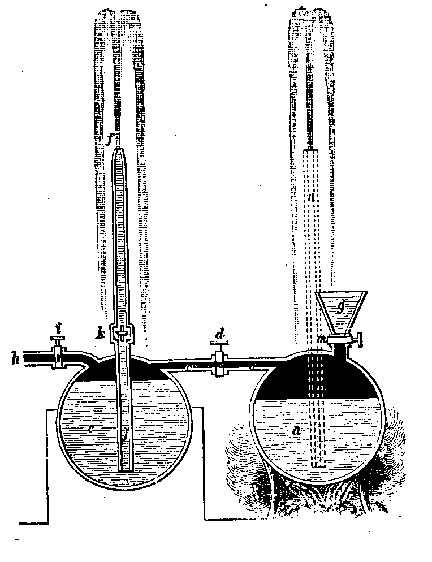
Fig. 7.Worcester's
Steam Fountain, A. D. 1664.
reproduce
it in all its details. Fortunately, the cells and grooves (Fig. 9) remaining in
the wall of the citadel of Raglan Castle indicate the general dimensions and
arrangement of the engine; and Direks, the biographer of the inventor, has
suggested the form of apparatus shown in the sketch (Fig. 8) as most perfectly
in accord with the evidence there found, and with the written specifications.
1
"Anecdotes of the Steam‑Engine," vol. i., p. 61.
The
two vessels, A A', are connected by a steampipe, BB', with the boiler, C,
behind them. D is the furnace. A vertical water‑pipe, X, is connected with the
cold water vessels, A A', by the pipes, FF', reaching nearly to the bottom.
Water is supplied by the pipes, GG', with valves, a a', dipping into the well
or ditch, W; Steam from the boiler being admitted to each vessel, A and ,1',
alternately, and there condensing, the vacuum formed d permits the pressure of
the atmosphere to force the water from the well through the pipes, G and G'.
While one is filling, the steam is forging the charge of water from the other
up the discharge‑pipe, 1a. As soon as each is emptied, the steam is shut off
from it and turned into the other, and the condensation of the steam remaining
in the vessel permits it to fill again. As will be seen presently, this is
substantially,
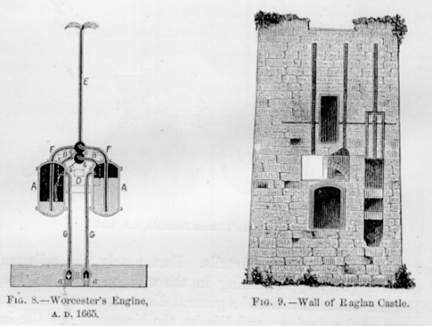
Fig.
8.-Worcester's Engine, A.D. 1665.
Fig. 9.Wall of Raglan Castle.
and
almost precisely, the form of engine of which the invention is usually
attributed to Savery, a later inventor.
Worcester
never succeeded in forming the great company which he hoped would introduce his
invention on a sale commensurate with its importance, and his fate was that of
nearly all inventors. He died poor and unsuccessful. His widow, who lived until
1681, seemed to have become as confident as was Worcester himself that the
invention had value, and, long after his death, was still endeavoring to secure
its introduction, but with equal nonsuccess. The steam‑engine had taken a form
which made it inconceivably valuable to the world, at a time when no more
efficient means of raising water was available at the most valuable mines than
horsepower; but the people, greatly as it was needed, were not yet
sufficiently intelligent to avail themselves of the great boon, the acceptance
of which was urged upon them with all the persistence and earnestness which
characterizes every true inventor.
Worcester
is described by his biographer as having been a learned, thoughtful, studious,
and good mana Romanist without prejudice or bigotry, a loyal subject, free
from partisan intolerance; as a public man, upright, honorable, and humane; as
a scholar, learned without being pedantic; as a mechanic, patient, skillful,
persevering, and of wonderful ingenuity, and of clear, almost intuitive,
apprehension.
xYet,
with all these natural advantages, reinforced as they were by immense wealth and
influence in his earlier life, and by hardly lessened social and political
influence when a large fortune had been spent in experiment, and after
misfortune had subdued his spirits and left him without money or a home, the
inventor failed to secure the introduction of a device which was needed more
than any other. Worcester had attained practical success; but the period of
speculation was but just closing, and that of the application of steam had not
quite yet arrived.
The second Marquis of Worcester stands on the record as the first steam‑engine
builder, and his death marks the termination of the first of those periods into
which we have divided the history of the growth of the steam‑engine.
The
" water‑commanding engine," as its inventor called it, was the first
instance in the history of the steam‑engine in which the inventor is known to
have " reduced his invention to practice."
It is
evident, however, that the invention of the separate boiler, important as it
was, had been anticipated by Porta, and does not entitle the marquis to the
honor, claimed for him by many English authorities, of being the inventor of
the steam‑engine. Somerset was simply one of those whose works collectively
made the steam engine.
xAfter
the time of Worcester, we enter upon 3 stage of history which may properly be
termed a period of application; and from this time forward steam continued to
play a more and more important part in social economy, and its influence on the
welfare of mankind augmented with a rapidly‑increasing growth.
The
knowledge then existing of the immense expansive force of steam, and the belief
that it was destined to submit to the control of man and to lend its immense
power in every department of industry, were evidently not confined to any one
nation. From Italy to Northern Germany, and from France to Great Britain, the
distances, measured in time, were vastly greater then than now, when this
wonderful genius has helped us to reduce weeks to hours; but there existed,
notwithstanding, a very perfect system of communication, and the learning of
every centre was promptly radiated to every other. It thus happened that, at
this time, the speculative study of the steam engine was confined to no part of
Europe; inventors and experimenters were busy everywhere developing this
promising scheme.
Jean
Hautefeuille, the son of a French bricklayer, born at Orleans, adopted by the
Duchess of Pouillon at the suggestion of De Sourdis, profiting by the great
opportunities offered him, entered the Church, and became one of the most
learned men and greatest mechanics of his time. He studied the many schemes
then brought forward by inventors with the greatest interest, and was himself
prolific of new ideas.
In
1678, he proposed the use of alcohol in an engine, "in such a manner that
the liquid should evaporate and be condensed, without being wasted the first
recorded plan, probably, for surface‑condensation and complete retention of the
working‑fluid." He proposed a gunpowder‑engine, of which he described
three varieties.
In one
of these engines he displaced the atmosphere by the gases produced by the
explosion, and the vacuum thus obtained was utilized in raising water by the
pressure of the air. In the second machine, the pressure of the gases evolved
by the combustion of the powder acted directly upon the water, forcing it
upward; and in the third design, the pressure of the vapor drove a piston, and
this engine was described as fitted to supply power for many purposes. There is
no evidence that he constructed these machines, however, and they are here
referred to simply as indicating that all the elements of the machine were
becoming well known, and that an ingenious mechanic, combining known devices,
could at this time have produced the steam engine. Its early appearance should
evidently have been anticipated.
xHautefeuille,
if we may judge from evidence at hand, was the first to propose the use of a
piston in a heat‑engine, and his gunpowder‑engine seems to have been the first
machine which would be called a heat engine by the modern mechanic. The earlier
" machines " or " engines," including that of Hero and
those of the Harquis of Worcester, would rather be denominated "
apparatus," as that term is used by the physicist or the chemist, than a
machine or an engine, as the terms are used by the engineer.
xHuyghens,
in l680, in a memoir presented to the Academy of Sciences, speaks of the
expansive force of gunpowder as capable of utilization as a convenient and
portable mechanical power, and indicates that he had designed a machine in
which it could be applied. This machine of Huyghens is of great interest, not
simply

Fig. 10.
Huyghens Engine, 1680.
because
it was the first gas‑engine and the prototype of the very successful modern
explosive gas‑engine of Otto and Iiangen, but principally as having been the
first engine wllich consisted of a cylinder and piston. The sketch shows its
form. It consisted of a cylinder, A, a piston, B, two relief‑pipes, C C, fitted
with check valves and a system of pulleys, g by which the weight is raised. The
explosion of the powder at expels the air from the cylinder. When the products
of combustion have cooled, the pressure of the atmosphere is no longer
counterbalanced by that of air beneath, and the piston is forced down, raising
the weight. The plan was never put in practice, although the invention was
capable of being made a working and possibly useful machine.
At
about this period the English attained some superiority over their neighbors on
the Continent in the practical application of science and the development of
the useful arts, and it has never since been lost. A sudden and great
development of applied science and of the useful arts took place during the
reign of Charles II., which is probably largely attributable to the interest
taken by that monarch in many branches of construction and of science. He is
said to have been very fond of mathematics, mechanics, chemistry, and natural
history, and to have had a laboratory erected, and to have employed learned men
to carry on experiments and lines of research for his satisfaction. He was especially
fond of the study and investigation of the arts and sciences most closely
related to naval architecture and navigation, and devoted much attention to the
determination of the best forms of vessels, and to the discovery of the best
kinds of ship‑timber. His brother, the Duke of York, was equally fond of this
study, and was his companion in some of his work.
Great
as is the influence of the monarch, to‑day, in forming the tastes and habits
and in determining the direction of the studies and labors of the people, his
influence was vastly more potent in those earlier days; and it may well be
believed that the rapid strides taken by Great Britain from that time were, in
great degree, a consequence of the well‑known habits of Charles II., and that
the nation, which had an exceptional natural aptitude for mechanical pursuits,
should have been prompted by the example of its king to enter upon such a
course as resulted in the early attainment of an advanced position in all
branches of applied science.
The
appointment, under Sir Robert Moray, the superintendent of the laboratory of
the king, of Master Mechanic, was conferred upon Sir Samuel Morland, a nobleman
who, in his practical knowledge of mechanics and in his ingenuity and
fruitfulness of invention, was apparently almost equal to Worcester. He was the
son of a Berkshire clergyman, was educated at Cambridge, where he studied
mathematics with great interest, and entered public life soon after. He served
the Parliament under Cromwell, and afterward went to Geneva. He was of a
decidedly literary turn of mind, and wrote a history of the Piedmont churches,
which gave him great repute with the Protestant party. He was induced
subsequently, on the accession of Charles II., to take service under that
monarch, whose gratitude he had earned by revealing a plot for his
assassination.
xHe
received his appointment in l660, and immediately commenced making experiments,
partly at his own expense and partly at the cost of the royal excellency; which
were usually not at all remunerative. He built hand fire‑engines of various
kinds, taking patents on them, wllich brought him as small profits as did his
work for the king, and invented the speaking‑trumpet, calculating machines, and
a capstan. His house at Vauxhall was full of curious devices, the products of
his own ingenuity.
He
devoted much attention to apparatus for raising water. His devices seem to have
usually been modifications of the now familiar force‑pump. They attracted much
attention, and exhibitions were made of them before the king and queen and the
court. He was sent to France on business relating to water‑works erected for
King Charles, and while in Paris he constructed pumps and pumping apparatus for
the satisfaction of Louis XIV. In his book,' published in Paris in 1683, and
presented to the king, and an earlier manuscript still preserved in the British
Museum, Borland shows a perfect familiarity with the power of steam. He says,
in the latter: " Water being evaporated by fire, the vapors require a greater
space (about two thousand times) than that occupied by the water; and, rather
than submit to imprisonment, it will burst a piece of ordnance. But, being
controlled according to the laws of static's, and, by science, reduced to the
measure of weight and balance, it bears its burden peaceably (like good
horses), and thus may be of great use to mankind, especially for the raising of
water, according to the following table, which indicates the number of pounds
which may be raised six inches, 1,800 times an hour, by cylinders half‑filled
with water, and of the several diameters and depths of said cylinders."
The
rate of enlargement of volume in the conversion of water into steam, as given
in Borland's book, appears remarkably accurate when compared with statements
made by other early experimenters. Desaguliers gave the ratio of volumes at
14,000, and this was accepted as correct for many years, and until Watt's
experiments, which were quoted by Dr. Robinson as giving the ratio at between
1,800 and 1,900. Morland also states the "duty " of his engines in
the same manner in which it is stated by engineers today.
Morland
must undoubtedly have been acquainted with the work of his distinguished ex
temporary Lord Worcester, and his apparatus seems most likely to have been a
modificationperhaps improvement of Worcester's engine. His house was at
Vauxhall, and the establishment set up for the king was in the neighborhood. It
may be that Morland is to be credited with greater success in the introduction
of his predecessor's apparatus than the inventor himself.
Dr. Hutton considered this book to have been the earliest account of the steam‑engine,
and accepts the date 1686 that of the invention, and adds, that " the
project seems to have remained obscure in both countries till 1699, when
Savery, who probably knew more of Morland's invention than he owned, obtained a
patent scarcely more complete or accurate knowledge of the extent of Morland's
work, and of its real value, than of that of Worcester. Morland died in 1696,
at Hammersmith, not far from London, and his body lies in Fulham church.
From
this time forward the minds of many mechanicians were earnestly at work on this
problem the raising of water by aid of steam. Hitherto, although many
ingenious toys, embodying the principles of the steam‑engine separately, and
sometimes to a certain extent collectively, had been proposed, and even
occasionally constructed, the world was only just ready to profit by the labors
of inventors in this direction.
But,
at the end of the seventeenth century, English miners were beginning to find
the greatest difficulty in clearing their shafts of the vast quantities of
water which they were meeting at the considerable depths to wllich they had
penetrated, and it had become a matter of vital importance to them to find a
more powerful aid in that work than was then available. They were, therefore,
by their necessities stimulated to watch for, and to be prepared promptly to
take advantage of, such an invention when it should be offered them.
The
experiments of Papin, and the practical application of known principles by
Savory, placed the needed apparatus in their hands.
Thomas Savery was a member of a well‑known family of Devonshire,
England, and was born at Shilston, about 1650. It was well educated, and became
a military engineer. He exhibited great fondness for mechanics, and for mathematicians
natural philosophy and gave much time
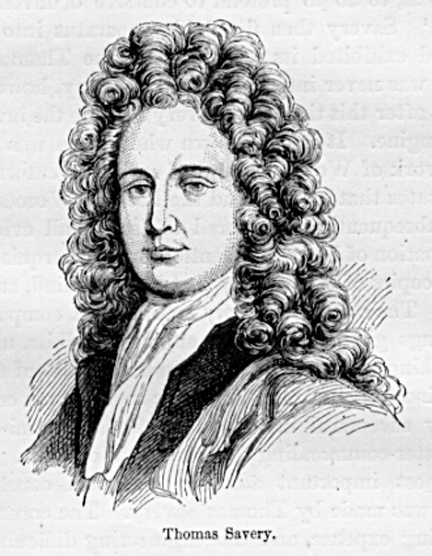
Thomas
Savery.
to
experimenting, to the contriving of various kinds of apparatus, and to
invention. He constructed a clock, wllich still remains in the family, and is
considered an ingenious piece of mechanism, and is said to be of excellent
workmanship.
He
invented and patented an arrangement of paddlewheels, driven by a capstan l for
propelling vessels in calm weather, and spent some time endeavoring to secure
its adoption by the British Admiralty and the Wavy Board, but met with no
success. The principal objector was the Surveyor of the Navy, who dismissed
Savery, with a remark which illustrates a spirit which, although not yet
extinct, is less frequently met with in the public service now than then:
" And have interloping people, that have no concern with us, to do to
pretend to contrive or invent things for 11S ? " I Savery then fitted his
apparatus into a small vessel, and exhibited its operation on the Thames. The
invention was never introduced into the navy, however.
It
was after this time that Savery became the inventor of a steam‑engine. It is
not known whether he was familiar with the work of Worcester, and of earlier
inventors. Desaguliersu states that he had read the book of Worcester, and that
he subsequently endeavored to destroy all evidence of the anticipation of his
own invention by the marquis by buying up all copies of the century that he
could find, and burning them. The story is scarcely credible. A comparison of
the drawings given of the two engines exhibits, nevertheless, a striking
resemblance; and, assuming that of the marquis's engine to be correct, Savery
is to be given credit for the finally successful introduction of the " semi‑omnipotent
" " water‑commanding " engine of Worcester.
The
most important advance in actual construction, therefore, was made by Thomas
Savery. The constant and embarrassing expense, and the engineering difficulties
presented by the necessity of keeping the British mines, and particularly the
deep pits of Cornwall, free from water, and the failure of every attempt
previously made to provide effective and economical pumping‑machinery, were
noted by Savery, who, July 2, 1698, patented the design of the first engine
which was ever actually employed in this work. A working‑model was submitted to
the Royal Society of London.
1
" Navigation Improved; or, The Art of Moving Ships of all rates in Calms,
with a more Easy, Swift, and Steady Motion, than Oars can," etc., etc. By
Thomas Savery, Gent. London, 1698.
2
Experimental Philosophy," vol. ii., p. 465.
Done
in 1699, and successful experiments were made with it Savery spent a
considerable time in planning his engine and in perfecting it, and states that
he expended large sums of money upon it.
Having
finally succeeded in satisfying himself with its operation, he exhibited a
model Fire‑Engine," as it was called in those days, before King William
III. and his court, at Hampton Court, in 1698, and obtained his patent without
delay. The title of the patent reads: "A grant to Thomas Savery of the
sole exercise of a new invention by him invented, for raising of water, and
occasioning motion to all sorts of mill‑works, by the important force of fire,
which will be of great use for draining mines, serving towns with water, and
for the working of all sorts of mills, when they have not the benefit of water
nor constant winds; to hold for 14 years; with usual clauses."
Savery
now went about the work of introducing his invention in a way which is in
marked contrast with that usually adopted by the inventors of that time. He
commenced a systematic and successful system of advertisement, and lost no
opportunity of making his plans not merely known, but well understood, even in
matters of detail. The Royal Society was then fully organized, and at one of
its meetings he obtained permission to appear with his model " fire‑engine
" and to explain its operation; and, as the minutes read, "Mr. Savery
entertained the Society with showing his engine to raise water by the force of
fire. He was thanked for showing the experiment, which succeeded, according to
expectation, and was approved of." It presented to the Society a drawing
and specifications of his machine, and "The Transactions"' contain a
copperplate engraving and the description of his model. It consisted of a
furnace, A, heating a boiler, B, which was connected by pipes, C C, with two
copper receivers, B B. There were led from the bottom of these receivers branch
pipes which turned upward, and were united to form a rising
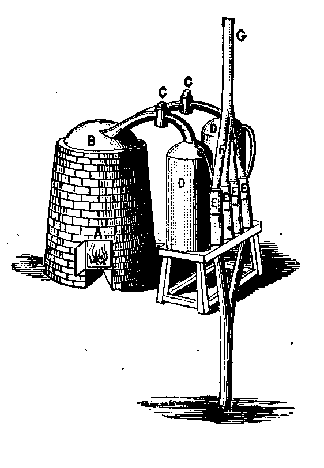
Fig. 11. Savery's Model, 1698.
main,
or " forcing‑pipe," G. From the top of each receiver was led a pipe,
which was turned downward, and these pipes united to form a suction pipe, which
was led down to the bottom of the well or reservoir from which the water was to
be drawn. The maximum lift allowable was stated at 24 feet.
1
"Philosophical Transactions, No. 252." World's " Royal
Society," vol. i., p. 357. Lowthorp's "Abridgment," vol. i.
The engine was worked as follows: Steam is raised in the boiler, B, and a cock,
C, being opened, a receiver, B, is filled with steam. Closing the cock, Cf, the
steam condensing in the receiver, a vacuum is created, and the pressure of the
atmosphere forces the water up, through the supply‑pipe, from the well into the
receiver. Opening the cock, C, again, the check‑valve in the suction‑pipe at
closes, the steam drives the water out through the forcing‑pipe, G, the clack
valve, 1], on that pipe opening before it, and the liquid is expelled from the
top of the pipe. The valve, Cf, is again closed; the steam again condenses, and
the engine is worked as before. While one of the two receivers is discharging,
the other is filling, as in the machine of the Marquis of Worcester, and thus
the steam is drawn from the boiler with tolerable regularity, and the expulsion
of water takes place with similar uniformity, the two systems of receivers and
pipes being worked alternately by the single boiler.
In
another and still simpler little machine, (1) which he erected at Kensington
(Fig. 12), the same general plan was adopted, combining a suction‑pipe, A, 16 feet long and 3 inches in
diameter; a single receiver, B, capable of containing 13 gallons; a boiler, C, of
about 40 gallons
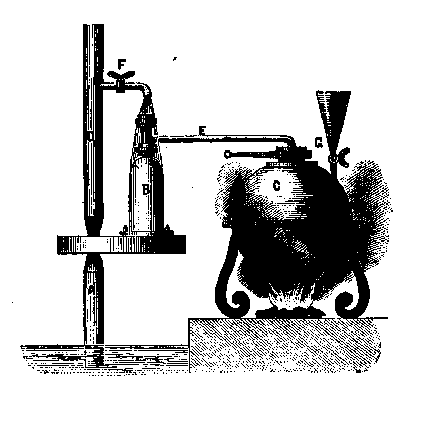
Fig.12-Savery's Engine, 1698.
capacity;
a forcing‑pipe, X, 42 feet high, with the connecting pipe and cocks, E F G; and
the method of operation was as already described, except that surf condensation
was employed, the cock, F, being arranged to shower water from the rising main over
the receiver, as shown. Of the first engine Switzer says: " I have heard
him say myself, that the very first time he played, it was in a potter's house
at Lambeth, where, though it was a small engine, yet it (the water) forced its
way through the roof, and struck off the tiles in a manner that surprised all
the spectators."
1
Bradley, " New Improvements of Planting and Gardening." Switzer,
" Hydrostatics," 1729.
The
Kensington engine cost of £50 raised 3,000 gallons per hour, filling the
receiver four times a minute, and required a bushel of coal per day. Switzer
remarks: " It must be noted that this engine is but a small one in
comparison with many others that are made for coal‑works; but this is
sufficient for any reasonable family, and other uses required of it in watering
all middling gardens." It cautions the operator: " When you have raised
water enough, and you design to leave off working the engine, take away all the
fire from under the boiler, and open the cock (connected to the funnel) to let
out the steam, which would otherwise, were it to remain confined, perhaps burst
the engine."
What
with the intention of making his invention more generally known, and hoping to
introduce it as a pumping‑engine in the mining districts of Cornwall, Savery
wrote a prospectus for general circulation, which contains the earliest account
of the later and more effective form of engine. He entitled his pamphlet "
The Miner's Friend; or, A Description of an Engine to raise Water by Fire
described, and the manner of fixing it in 3 lines, with an account of the
several uses it is applicable to, and an Answer to the Objections against
it." It was printed in London in 1702, for S. Crouch, and was distributed
among the proprietors and managers of mines, who were then finding the flow of
water at depths so great as, in some cases, to bar further progress. In many
cases, the cost of drainage left no satisfactory margin of profit. In one mine,
500 horses were employed raising water, by the then usual method of using horse
gins and buckets.
The
approval of the hiring and of the Royal Society, and the countenance of the
mine‑adventurers of England, were acknowledged by the author, who addressed his
pamphlet to them.
The
engraving of the engine was reproduced, with the description, in Harris's
"Lexicon Technician," in Switzer's " Hydrostatics," 1729;
and in Desagulier's "Experimental Philosophy," 1744. The sketch which
here follows is a neater engraving of the same machine. Savery's engine is
shown in Fig. 16, as described by Savery himself, in 1702, in " The
Miner's Friend."
LL is
the boiler in which steam is raised, and through the pipes 00 it is alternately
let into the vessels PP.
Suppose
it to pass into the left‑hand vessel first. The valve 211 being closed, and,
being opened, the water contained in P is driven out and up the pipe S to the
desired height, where it
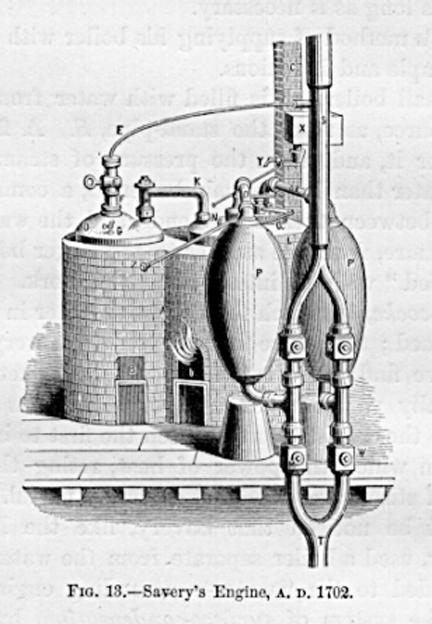
Fig. 13.-Savery's Engine, A.D. 1702.
is
discharged. The valve r is then closed, and the valve in the pipe O; the valve
is next opened, and condensing water is turned upon the exterior of P by the
cock X, leading water from the cistern XY. As the steam contained inside is
condensed, forming a vacuum there, a fresh charge Of water is driven by
atmospheric pressure up the pipe. Meantime, steam from the boiler has been let
into the right‑hand vessel Pyv, the cock W having been first closed, and X
opened.
The
charge of water is driven out through the lower pipe and the cock P, and up the
pipe S as before, while the other vessel is refilling preparatory to acting in
its turn. The two vessels are thus alternately charged and discharged, as long
as is necessary.
Savery's
method of supplying his boiler with water was at once simple and ingenious. The
small boiler, B, is filled with water from any convenient source, as from the
stand‑pipe, S. A fire is then built under it, and, when the pressure of steam
in s becomes greater than in the main boiler, L, a communication is opened
between their lower ends, and the water passes, under pressure, from the
smaller to the larger boiler, which is thus "fed " without
interrupting the work. G and N are garbage‑cocks, by which the height of water
in the boilers is determined; they were first adopted by Savery. Here we find,
therefore, the first really practicable and commercially valuable steam‑engine.
Thomas Savery is entitled to the credit of having been the first to introduce a
machine in which the power of heat, acting through the medium of steam, was
rendered generally useful.
It
will be noticed that Savery, like the Marquis of Worcester, used a boiler
separate from the water reservoir.
He
added to the "water‑commanding engine " of the marquis the system of
surface‑condensation, by which he was enabled to charge his vessels when it
became necessary to refill them; and added, also, the secondary boiler, which
enabled him to supply the working‑boiler with water without interrupting its
work.
The
machine was thus made capable of working uninterruptedly for a period of time
only limited by its own decay. Savery never fitted his boilers with safety‑valves,
although it was done later by others; and in deep mines he was compelled to
make use of higher pressures than his rudely‑constructed boilers could safely
bear.
It
was also used for supplying water to towns; some large estates, country houses,
and other private establishments, employed them for the same purpose. They did
not, however, come into general use among the mines, because, according to
Desaguliers, they were apprehensive of danger from the explosion of the boilers
or receivers. As Desaguliers wrote subsequently: " Savery made a great
many experiments to bring this machine to perfection, and did erect several
which raised water very well for gentlemen's seats, but could not succeed for
mines, or supplying towns, where the water was to be raised very high and in
great quantities; for then the steam required being boiled up to such a
strength as to be ready to tear all the vessels to pieces." "I have
known (Captain Savery, at York's buildings, to make steam eight or ten times
stronger than common air; and then its heat was so great that it would melt
common soft solder, and its strength so great as to blow open several joints of
the machine; so that he was forced to be at the pains and charge to have all
his joints soldered with hard solder."
Although there were other difficulties in the application of the Savery engine
to many kinds of work, this was the most serious one, and explosions did occur
with fatal results. The writer just quoted relates, in his " Experimental
Philosophy," that a man who was ignorant of the nature of the engine
undertook to work a machine which Desaguliers had provided with a safety‑valve
to avoid this very danger, " and, having hung the weight at the further
end of the steelyard, in order to collect more steam in order to make his work
the quicker, he hung also a very heavy plumber's iron upon the end of the
steelyard; the consequence proved fatal; for, after some time, the steam, not
being able, with the safety‑cock, to raise up the steelyard loaded with all
this unusual weight, burst the boiler with a great explosion, and killed the
poor man." This is probably the earliest record of a steam‑boiler
explosion.
Savery
proposed to use his engine for driving mills; but there is no evidence that he
actually made such an application of the machine, although it was afterward so
applied by others. The engine was not well adapted to the drainage of surface‑land,
as the elevation of large quantities of water through small heights required
great capacity of receivers, or compelled the use of several engines for each
case. The filling of the receivers, in such cases, also compelled the heating
of large areas of cold and wet metallic surfaces by the steam at each
operation, and thus made the work comparatively wasteful of fuel. Where used in
mines, they w‑ere necessarily placed within 30 feet or less of the lowest
level, and were therefore exposed to danger of submergence whenever, by any
accident, the water should rise above that level. In many cases this would
result in the loss of the engine, and the mine would remain
"drowned," unless another engine should be procured to pump it out.
Where the mine was deep, the water was forced by the pressure of steam from the
level of the engine‑station to the top of the lift. This compelled the use of
pressures of several atmospheres in many cases; and a pressure of three
atmospheres, or about 4D pounds per square inch, was considered, in those days,
as about the maximum pressure allowable. This difficulty was met by setting a
separate engine at every 60 or 80 feet, and pumping the water from one to the
other. If any one engine in the set became disabled, the pumping was
interrupted until that one machine could be repaired. The size of Savery's
largest boilers was not great, their maximum diameter not exceeding two and a
half feet. This made it necessary to provide several of his engines, usually,
for a single mine, and at each level. The first cost and the expense of repairs
were exceedingly serious items. The expense and danger, either real or
apparent, were thus sufficient to deter many from their use, and the old method
of raising water by horse‑power was adhered to.
The
consumption of fuel with these engines was very great. The steam was not
generated economically, as the boilers used were of such simple forms as only
could then be produced, and presented too little heating surface to secure a
very complete transfer of heat from the gases of combustion to the water within
the boiler This waste in the generation of steam in these uneconomical boilers
was followed by still more serious waste in its application, without expansion,
to the expulsion of water from a metallic receiver, the cold and wet sides of
which absorbed heat with the greatest avidity The great mass of the liquid w as
not, however, heated by the steam, and was expelled at the temperature at which
it was raised from below
Savery quaintly relates the action of his machine in " The Miner's
Friend," and so exactly, that a better description could scarcely be asked
" The steam acts upon the surface of the water in the receiver, which
surface only being heated by the steam, it does not condense, but the steam gravitates
or presses with an elastic quality like air, and still increasing its
elasticity or spring, until it counterpoises, or rather exceeds, the weight of
the column of water in the forcepipe, which then it will necessarily drive up
that pipe; the steam then takes some time to recover its power, but it will at
last discharge the water out at the top of the pipe You may see on the outside
of the receiver how the water goes out, as well as if it were transparent; for,
so far as the steam is contained within the vessel, it is dry without, and so
hot as scarcely to endure the least touch of the hand; but so far as the water
is inside the vessel, it will be cold and wet on the outside, where any water
has fallen on it; which cold and moisture vanish as fast as the steam takes the
place of the water in its descent "
After
Savery's death, in 1716, several of these engines were erected in which some
improvements were introduced Dr. Desaguliers, in 1718, built a Savery engine,
in which he avoided some defects which he, with Gravesande, had noted two years
earlier. They had then proposed to adopt the arrangement of a single receiver
which had been used by Savery himself, as already described, finding, by
experiment on a model which they had made for the purpose, that one could be
discharged three times, while the same boiler would empty two receivers but
once each. In their arrangement, the steam was shut back in the boiler while
the receiver was filling with water, and a high pressure thus accumulated,
instead of being turned into the second receiver, and the pressure thus kept
comparatively low.
In
the engine built in 1718, Desaguliers used a spherical boiler, which he
provided with the lever safety‑valve already applied by Papin, and adopted a
comparatively small receiverone‑fifth the capacity of the boilerof slender
cylindrical form, and attached a pipe leading the water for condensation into
the vessel, and effected its distribution by means of the " rose," or
a " sprinkling‑plate," such as is still frequently used in modern
engines having jet‑condensers. This substitution of jet for surface‑condensation
was of very great advantage, securing great promptness in the formation of a
vacuum and a rapid filling of the receiver. A " two‑way cock "
admitted steam to the receiver, or, being turned the other way, admitted the
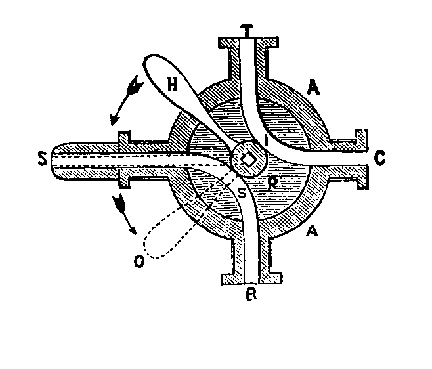
Fig. 14.-Papin's Two-Way Cock.
cold
condensing water. The dispersion of the water in minute streams or drops was a
very important detail, not only as securing great rapidity of condensation, but
enabling the designer to employ a comparatively small receiver or condenser.
The engine is shown in Fig. 1S, which is copied from the "Experimental
Philosophy" of Desaguliers.
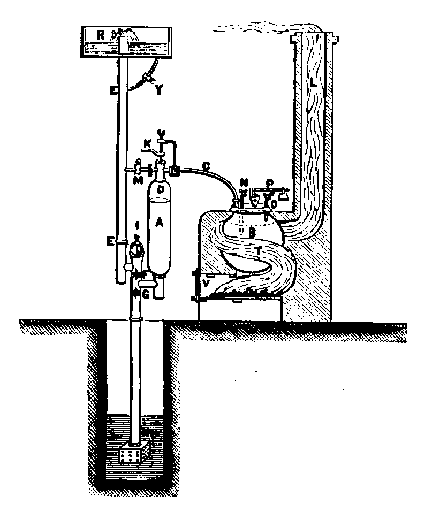
Fig. 15. -
Engine built by Desagulier in 1718.
The
receiver, A, is connected to the boiler, B, by a steam‑pipe, C, terminating at
the two‑way cock, 19; the " forcing‑pipe," E, has at its foot a check‑valve,
g and the valve G is a similar check at the head of the suction‑pipe. A is a
strainer, to prevent the ingress of chips or other bodies carried to the pipe
by the current; the cap above the valves is secured by a bridle, or stirrup,
and screw, 1; and may be readily removed to clear the valves or to renew them;
K is the handle of the two‑way cock; M is the injection‑cock, and is kept open
during the working of the engine; L is the chimney flue; 1V and O are gauge‑cocks
fitted to pipes leading to the proper depths within the boiler, the water‑line
being somewhere between the levels of their lower ends; P is a lever safety‑valve,
as first used on the "Digester" of Papin; R is the reservoir into
which the water is pumped; T is the flute, leading spirally about the boiler
from the furnace, V; to the chimney; :}~ is a cork fitted in a pipe through
which the rising‑main may be filled from the reservoir, should injection‑water
be needed when that pipe is empty.
Seven
of these engines were built, the first of which was made for the Czar of
Russia. Its boiler had a capacity of "five or six hogsheads," and the
receiver, "holding one hogshead," was filled and emptied four times a
minute. The water was raised " by suction " 29 feet, and forced by
steam pressure 11 feet higher.
Another
engine built at about this time, to raise water 29 feet " by
suction," and to force it 24 feet higher, made G " strokes " per
minute, and, when forcing water but 6 or 8 feet, made 8 or 9 strokes per
minute. Twenty-five years later a workman overloaded the safety valve of this
engine, by placing the weight at the end and then adding " a very heavy
plumber's iron." The boiler exploded, killing the attendant.
Desagulier
says that one of these engines, capable of raising ten tons an hour 38 feet, in
1728 or 1729, cost £80, exclusive of the piping.
Blakely,
in 1726, patented an improved Savery engine, in which he endeavored to avoid
the serious loss due to condensation of the steam by direct contact with the
water, by interposing a cushion of oil, which floated upon the water and
prevented the contact of the steam with the surface of the water beneath it. He
also used air for the same purpose, sometimes in double receivers, one
supported on the other. These plans did not, however, prove satisfactory.
Rigley,
of Manchester, England, soon after erected Savery engines, and applied them to
the driving of mills, by pumping water into reservoirs, from where it returned
to the wells or ponds from which it had been raised, turning water‑wheels as it
descended.
Such
an arrangement was in operation many years at the works of a Mr. Kiers, St.
Pancras, London. It is described in detail, and illustrated, in Nicholson's
" Philosophical Journal," vol. i., p. 419. It had a "wagonboiler
" 7 feet long, 5 wide, and 5 deep; the wheel was 18 feet in diameter, and
drove the lathes and other machinery of the works. In this engine Blakely's
plan of injecting air was adopted. The injection‑valve was a clack, which closed
automatically when the vacuum was formed. The engine consumed 6 or 7 bushels of
good coals, and made 10 strokes per minute, raising 70 cubic feet of water 14
feet, and developing nearly 3 horse‑power.
Many
years after Savery's death, in 1774, Smeaton made the first duty‑trials of
engines of this kind. He found that an engine having a cylindrical receiver 16
inches in diameter and 22 feet high, discharging the water raised 14 feet above
the surface of the water in the well, making 12 strokes, and raising 100 cubic
feet per minute, developed 23 horsepower, and consumed 3 hundredweight of coals
in four hours. Its duty was, therefore, 5,250,000 pounds raised one foot per
bushel of 84 pounds of coals, or 62,500 "footpounds " of work per
pound of fuel. An engine of slightly greater size gave a duty about 5 per cent.
greater.
When
Louis XIV. revoked the edict of Nantes, by which Henry IV. had guaranteed
protection to the Protestants of France, the terrible persecutions at once
commenced drove from the kingdom some of its greatest men. Among these was
Denys Papin.
It
was at about this time that the influence of the atmospheric pressure on the
boiling‑point began to be observed, Dr. Cooke having found that the boiling
point was a fixed temperature under the ordinary pressure of the atmosphere,
and the increase in temperature and pressure of steam when confined having been
shown by Papin with his " Digester."
Dennis Papin was of a family which had attached itself to the Protestant
Church; but he was given his education in the school of the Jesuits at Blois,
and there acquired his knowledge of mathematics. His medical education was
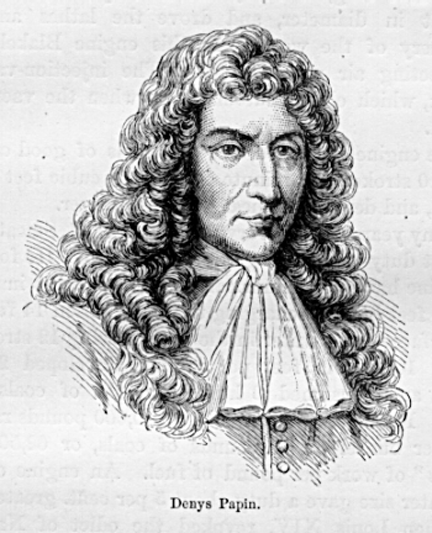
Denys Papin.
given
him at Paris, although he probably received his degree at Orleans. He settled
in Paris in 1672, with the intention of practicing his profession, and devoted
all his spare time, apparently, to the study of physics.
Meantime, that distinguished philosopher, Huyghens, the inventor of the clock
and of the gunpowder‑engine, had been induced by the linen draper's apprentice,
Colbert, now the most trusted adviser of the king, to take up his residence in
Paris, and had been made one of the earliest members of the Academy of Science,
which was founded at about that time. Papin became an assistant to Huyghens,
and aided him in his experiments in mechanics, having been introduced by Madame
Colbert, who was also a native of Blois. Here he devised several modifications
of the instruments of Guericke, and printed a description of them. This little
book was presented to the Academy, and very favorably noticed. Papin now became
w ell known among contemporary men of science at Paris, and was well received
everywhere. Soon after, in the year 1678 as stated by the Joureeal des Savants,
he left Palis and took up his residence in England, where he very soon made the
acquaintance of Robert Boyle, the founder, and of the members of the Royal
Society.
Boyle speaks of Papin as having gone to England in the hope of finding a place
in which he could satisfactorily pursue his favorite studies. Boyle himself had
already been long engaged in the study of pneumatics, and had been especially
interested in the investigations which had been original with Guericke. He
admitted young Papin into his laboratory, and the two philosophers worked
together at these attractive problems. It was while working with Boyle that
Papin invented the double air‑pump and the air gun. Papin and his work had now
become so well known, and he had attained so high a position in science, that
he was nominated for membership in the Royal Academy, and was elected December
16, 1680. He at once took his place among the most talented and distinguished
of the great men of his time. He probably invented his " Digester "
while in England, and it was first described in a brochure written in English,
under the title, " The New Digester." It was subsequently published
in Paris. This was a vessel, B (Fig. 16), capable of being tightly closed by a
screw, D, and a lid, C, in
l
"Nouvelles Experiences du Vuide, avec la descriptions mechanics qui
servent a le fairc." Paris, 1674.
2
"La manierc d'anlollir les os et de faire cuire toutes sortes dc viandes,"
etc.
which
food could be cooked in water raised by a furnace, A, to the temperature due to
any desired safe pressure of steam. The pressure was determined and limited by
a weight, W; on the safety‑valve lever, G. It is probable that this essential
attachment to the steam‑boiler had previously been used for other purposes; but
Papin is given the credit of having first made use of it to control the
pressure of steam.
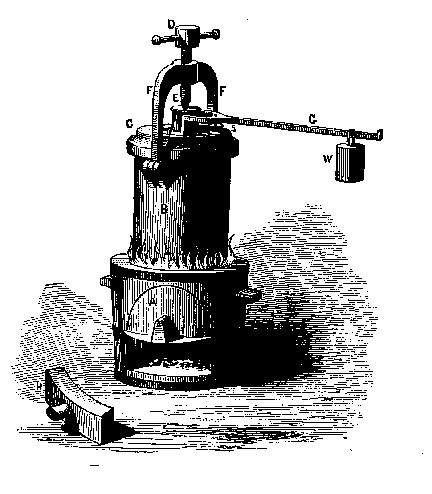
Fig. 16.Papin's
Digester, 1680.
From
England, Papin went to Italy, where he accepted membership and held official
position in the Italian Academy of Science. Then, in 1687, he announced one of
his inventions, which is just becoming of great value in the arts. He proposed
to transmit power from one point to another, over long distances, by the now
well‑known " pneumatic " method. At the point where power was
available, he exhausted a chamber by means of an air‑pump, and, leading a pipe
to the distant point at which it was to be utilized, there withdrew the air
from behind a piston, and the pressure of the air upon the latter caused it to
recede into the cylinder, in which it was fitted, raising a weight, of which
the magnitude was proportionate to the size of the piston and the degree of
exhaustion. Papin was not satisfactorily successful in his experiments; but he
had created the germ of the modern system of pneumatic transmission of powder.
His disappointment at the result of his efforts to utilize the system was very
great, and he became despondent, and anxious to change his location again.
In 1687 he was offered the chair of Mathematics at Marburg by Charles, the
Landgrave of Upper Hesse, and, accepting the appointment, went to Germany. He
remained in Germany many years, and continued his researches with renewed
activity and interest. His papers were published in the " Acta Eruditorum
" at Leipsic, and in the " Philosophical Transactions " at
London. It was while at Marbllrg that his papers descriptive of his method of
pneumatic transmission of power were printed.(1)
In
the "Acta Eruditorum" of 1688 he exhibited a practicable plan, in
which he exhausted the air from a set of engines or pumps by means of pumps
situated at a long distance from the point of application of the power, and at
the place where the prime mover which was in this case a water‑wheelwas
erected.
After his arrival at the University of Marburg, Papin exhibited to his
colleagues in the faculty a modification of Huyghens's gunpowder‑engine, in
which he had endeavored to obtain a more perfect vacuum than had Huyghens in
the first of these machines. Disappointed in this, he finally adopted the
expedient of employing steam to displace the air, and to produce, by its
condensation, the perfect vacuum which he sought; and he thus produced the
first mechanical steam engine and the first piston steam‑engine, in which
condensation was produced to secure a vacuum. It w as described in the "
Acta " of Leipsic in June, 1690, under the title, " Nova Methodus ad
vires motrices validissimas leri pretio comparandeo " (" A New Method
of securing cheaply Motive Power of considerable Magnitude "). He
describes first the gunpowder‑engine, and continues by stating that,
"until now, all experiments have been unsuccessful; and after the
combustion of the exploded powder, there always remains in the cylinder about
one‑fifth its volume of air." He says that he has endeavored to arrive by
another route at the same end; and " as, by a natural property of water, a
small quantity of this liquid, vaporized by the action of heat, acquires an
elasticity like that of the air, and returns to the liquid state again on
cooling, without retaining the least trace of its elastic force," he
thought that it would be easy to construct machines in which, " by means
of a moderate heat, and without much expense," a more perfect vacuum could
be produced than could be secured by the use of gunpowder. The first machine of
Papin (Fig. 17) was very similar to the gunpowder engine already described as
the invention of Huyghens. In place of gunpowder, a small quantity of water is
placed at the bottom of the cylinder, A; a fire is built beneath it, " the
bottom being made of very thin metal," and the steam formed
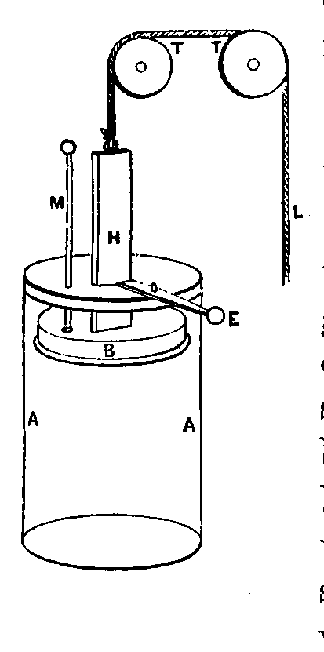
Fig. 17.Papin's engine.
soon
raises the piston, B, to the top, where a latch, E, engaging a notch in the
piston‑rod, W; holds it up until it is desired that it shall
1
" Acta Eruditorum," Leipsic, 1690.
drop.
The fire being removed, the steam condenses, and a vacuum is formed below the
piston, and the latch, E, being disengaged, the piston is driven down by the super
incumbent atmosphere and raises the weight which has been, meantime, attached
to a rope, L, passing from the piston‑rod over pulleys, T T. The machine had a
cylinder two and a half inches in diameter, and raised 60 pounds once a minute;
and Papin calculated that a machine of a little more than two feet diameter of
cylinder and of four feet stroke would raise 8,000 pounds four feet per minutei.
e., that it would yield about one horse‑power.
The inventor claimed that this new machine would be found useful in relieving
mines from water, in throwing bombs, in ship‑propulsion, attaching revolving
paddlesi. e., paddle‑wheelsto the sides of the vessel, which wheels were to
be driven by several of his engines, in order to secure continuous motion, the
piston‑rods being fitted with racks which were to engage ratchet‑wheels on the
paddle‑shafts.
"The principal difficulty," he says, answering anticipated
objections, " is that of making these large cylinders." In a reprint
describing his invention, in 1695, Papin gives a description of a " newly‑invented
furnace," a kind of fire‑box steam‑boiler, in which the fire, completely
surrounded by water, makes steam so rapidly that his engine could be driven at
the rate of four strokes per minute by the steam supplied by it.
Papin also proposed the use of a peculiar form of furnace with this engine,
which, embodying as it does some suggestions that very probably have since been
attributed to later inventors, deserves special notice. In this furnace, Papin
proposed to burn his fuel on a grate within a furnace arranged with a the air
entering above the grate, passing through the fire, and from the ash‑pit
through a side flue to the chimney. In starting the fire, the coal was laid on
the grate, covered with wood, and the latter was ignited, the flame, passing
downward through the coal, igniting that in turn, and, as claimed by Papin, the
combustion was complete, and the formation of smoke was entirely prevented. He
states, in " Acta Eruclitorum," that the heat was intense, the saving
of fuel very great, and that the only difficulty was to find a refractory
material which would withstand the high temperature attained.
This is the first fire‑box and fire boiler of which w‑c have record. The
experiment is supposed to have had Papin to suggest the use of a hot‑blast, as
practiced by Neilson more than a century later, for reducing metals from their
ores.
Papin made another boiler having a flue winding through the water‑space, and
presenting a heating surface of nearly 80 square feet. The flue had a length of
21 feet, and was about 10 inches square. It is not stated what were the maximum
pressures carried on these boilers; but it is known that Papin had used very
high pressures in his digestersprobably between 1,200 and 1,000 pounds per
square inch.
In the year 1705, Leibnitz, then visiting England, had seen a Savery engine,
and, on his return, described it to Papin, sending him a sketch of the machine.
Papin read the letter and exhibited the sketch to the Landgrave of Ilese, and
Charles at once urged him to endeavor to perfect his own machine, and to
continue the researches which he had been intermittently pursuing since the
earlier machine had been exhibited in public.
In a small pamphlet printed at Cassel in 1607,(1) Papin describes a new form of
engine, in which he discards the original plan of a modified Huyghens engine,
with tightening piston and cylinder, raising its load by indirect action, and
makes a modified Savery engine, which he calls the "Elector's Engine,"
in honor of his patrol. This is the engine shown in the engraving, and as
proposed to be used by him in turning a water-wheel.
1
"Nouvelle maniere d'61evtl I'Eau par la Force du Feu, mis eu Lumiere, par
D. Papin. cass 1707.
The
sketch is that given by the inventor in his memoir. It consists (Fig. 18) of a
steam‑boiler, a, from which steam is led through the leak, c, to the working
cylinder, ve. The water beneath the floating‑piston, / w, which latter serves
simply as a cushion to protect the steam from sudden condensation or contact
with the water, is forced into the vessel, which
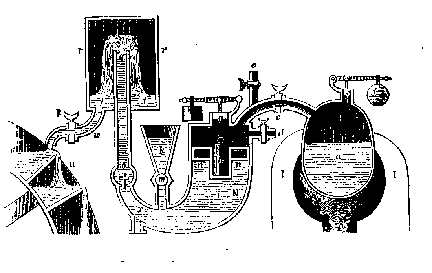
Fig 18.Papin's
Engine and Water Wheel, A.D. 1707.
is a
large air‑chamber, and which serves to render the outflow of water
comparatively uniform, and the discharge occurs by means of the pipe ¢7, from
which the water rises to the desired height. A fresh supply of water is
introduced through the funnel after condensation of the steam in, and the
operation of expulsion is repeated.
This machine is evidently a retrogression, and Papin, after having earned the
honor of having invented the first steam‑engine of the typical form which has
since become so universally applied, forfeited that credit by his evident
ignorance of its superiority over existing devices, and attempting
unsuccessfully to perfect the inferior device of another inventor.
Subsequently, Papin made an attempt to apply the steam‑engine to the propulsion
of vessels, the account of which will be given in the chapter on Steam
Navigation.
Again disappointed, Papin once more visited England, to renew his acquaintance
with the servants of the Royal Society; but Boyle had died during the period
which Papin had spent in Germany, and the unhappy and disheartened inventor and
philosopher died in 1810, without having seen any one of his many devices and
ingenious inventions a practical success.